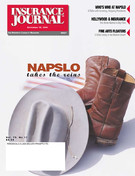The market for intellectual property (IP) insurance, traditionally a relatively small, specialized niche in the overall insurance market, is undergoing a growth spurt as policyholders recognize, and seek protection for, the value of their intangible assets; and the number of insurers offering IP coverage is expected to increase.
Until now, according to an analysis by KPMG, the difficulties involved in writing IP policies have kept many insurance companies away from the business and some companies that gave it a try left quickly after discovering the haziness involved in valuing intangibles.
Difficulties in writing IP coverage stem from the fact that intellectual property exposures provide a limited actuarial history, unlike other P/C markets with solid data that can be used to assess the likelihood, timing and severity of potential claims.
In addition, IP issues concern less concrete concepts than, say, auto insurance, where the insured object has a known value. Intellectual property, which involves the concept that ideas, information, or brands can be worth more than the company’s physical property, is not only harder to value but also more difficult to discern where damage, such as infringement, has occurred.
The IP market also carries with it a shortage of litigation history, since many of the companies that may need IP coverage today were not in existence five years ago and may not have been involved in legal action.
IP perils tend to fall outside liability coverages, and in order to be successful, insurers are cautioned to look at the segment as a property risk rather than an extension of general liability or E&O policies. Theft of intellectual property usually leads to a lawsuit, and one unusual aspect of IP insurance is that the policies need to cover the plaintiff’s legal fees in the event of a patent infringement case.
Despite the difficulties involved in underwriting IP policies, the need for such coverage still exists. For some companies, protecting ideas, brand names, a company’s image and research projects may be as important as, or more important than, protecting physical property.
Costs associated with a patent infringement case, a product recall that damages a company’s brand image, or the theft of trade secrets have the potential to bring a business down. During 1999, companies spent an average of $1.5 million per piece of patent litigation. The average in some locations jumped to $2.5 million and costs as high as $10 million per case were not unknown.
Current thinking is that as more IP policies are written, the easier the coverage will be to underwrite. Plus, as corporate America better understands how the value of its intangibles relates to the overall organization, better value judgments can be made. And several products are currently available that address many of the perils associated with intellectual property.
When writing IP coverage, insurers need to keep in mind that adjustments to policies in the early stages are often necessary, and underwriters need to take careful consideration of a company’s risk exposure and role in the marketplace. The size of a company or institution may also affect the way a policy is written to protect their balance sheets, cash flow and business objectives.
Insurers also need to be aware that not only should the cost of the property be considered but also the value of the associated risk. Business interruptions, loss of profits, whether a patent lawsuit will put a company out of business, and how much it will cost to get it into business again are all factors that may impact intellectual property policies.
Topics Property
Was this article valuable?
Here are more articles you may enjoy.


 MAPFRE Accuses AAA of Violating Long-Time Exclusive Marketing Agreement
MAPFRE Accuses AAA of Violating Long-Time Exclusive Marketing Agreement  Relief But Questions on Agents’ Duties to Insureds After Florida Court Ruling
Relief But Questions on Agents’ Duties to Insureds After Florida Court Ruling  High-Net-Worth Risk Appetite Drops as Some Regions Show Stabilization
High-Net-Worth Risk Appetite Drops as Some Regions Show Stabilization  Longtime Motel 6 Spokesman Tom Bodett Settles Lawsuit Against Chain
Longtime Motel 6 Spokesman Tom Bodett Settles Lawsuit Against Chain 


